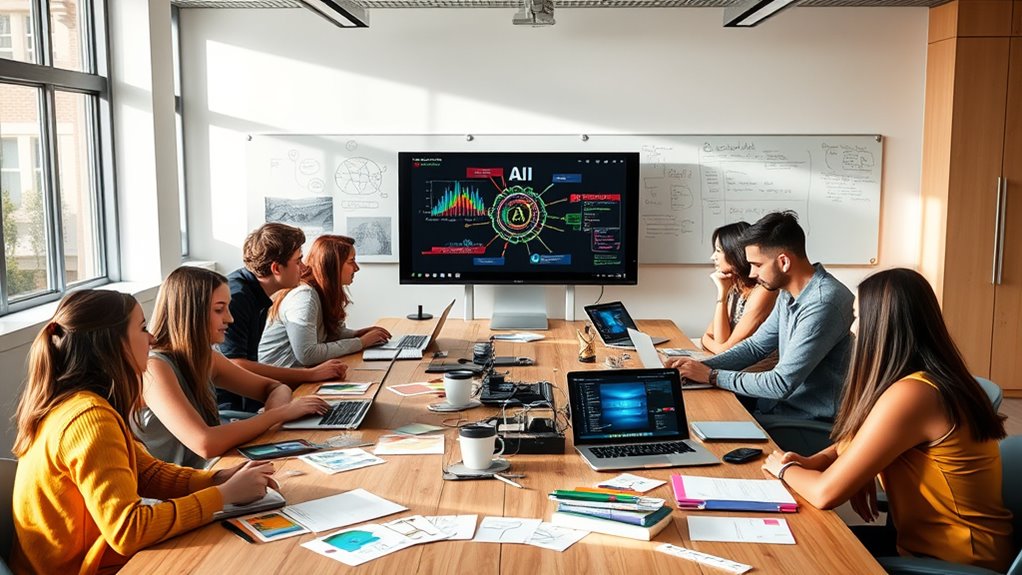In this case study, university students use AI to enhance collaboration, research, and problem-solving. They leverage AI-powered platforms to brainstorm, validate ideas, and track progress in real time. AI helps analyze data quickly and generate visualizations that make presentations engaging. It also suggests innovative solutions and offers personalized feedback, boosting creativity and outcomes. By integrating AI, students improve teamwork and efficiency. Keep exploring to discover how these strategies transform their project experiences.
Key Takeaways
- Students leverage AI tools for data analysis, idea generation, and coding, accelerating project development and enhancing quality.
- AI-powered collaboration platforms facilitate brainstorming, task division, and real-time communication among student teams.
- Researchers utilize AI to quickly review literature, extract insights, and create engaging data visualizations for presentations.
- AI provides personalized feedback, suggests innovative solutions, and encourages experimentation to improve project outcomes.
- The case emphasizes integrating cybersecurity and organization strategies to protect data and foster adaptive, AI-driven teamwork.

For university students, integrating AI assistance into their projects has become a game-changer. It transforms the way you approach problem-solving, research, and teamwork. When you incorporate AI integration into your workflow, you gain tools that can analyze data faster, generate ideas, and even help with coding or writing. This not only accelerates your progress but also elevates the quality of your work. As you collaborate with peers, AI becomes a shared resource that enhances student collaboration. Instead of each person working in isolation, your team can leverage AI-powered platforms to brainstorm, validate ideas, and divide tasks more effectively. This fosters a more dynamic, interactive environment where everyone’s input is amplified by technology.
Imagine you’re working on a research project. With AI tools, you can quickly sift through vast amounts of literature, extract relevant information, and identify key themes. Your team can then discuss insights, supported by AI-generated summaries, making meetings more productive. AI integration streamlines communication, allowing you to focus on critical thinking and creative aspects rather than getting bogged down in data collection. It also encourages student collaboration by providing a common platform where all members can contribute, share AI-generated insights, and track progress in real time. This seamless cooperation helps prevent miscommunications and ensures everyone stays on the same page.
Moreover, AI assists in brainstorming sessions, suggesting innovative approaches or alternative solutions you might not have considered. When you incorporate AI into your project, it becomes an extension of your team’s collective intelligence. This collaborative synergy helps you tackle complex challenges more effectively. Students who embrace AI integration often find they learn faster and produce more polished results. It also encourages a culture of experimentation and continuous learning, as students see firsthand how AI can complement their skills and knowledge. Additionally, integrating AI tools can serve as a learning enhancement by providing immediate feedback and personalized recommendations to improve your work. Incorporating effective collaboration strategies with AI tools can further maximize your team’s productivity and innovation.
In addition, incorporating home theatre projectors into your research can inspire innovative ways to visualize data and presentations, making your projects more engaging and impactful. Utilizing cybersecurity awareness in your workflow can also help protect your project data from potential threats and unauthorized access.
In essence, AI integration isn’t just about using a tool—it’s about transforming the way you collaborate and work as a team. It makes your project more efficient, creative, and adaptable. By leveraging AI assistance, you and your peers can push the boundaries of traditional academic work, producing innovative solutions and gaining valuable experience in modern technological applications. As you progress through your project, you’ll see how AI helps you stay organized, generate new ideas, and work more cohesively. This approach prepares you for future careers where AI-driven teamwork will be essential, giving you a competitive edge and a deeper understanding of how technology can elevate your academic and professional pursuits.
Frequently Asked Questions
What Specific AI Tools Did Students Use for Their Project?
You’re curious about the AI tools students used for their project. They carefully selected AI tools that supported their goals, focusing on tools like chatbots, data analysis platforms, and coding assistants to enhance student collaboration. By choosing the right AI tools, they streamlined their workflow and improved communication. Their AI tool selection allowed them to work efficiently, innovate, and successfully complete their project together.
How Did AI Influence Students’ Learning Experiences?
AI collaboration markedly boosts your learning experience by making complex concepts more accessible and interactive. It encourages greater student engagement, as you actively participate in problem-solving and creative tasks. With AI tools, you gain immediate feedback, which helps you learn faster and stay motivated. Overall, AI transforms your educational journey into a more dynamic, personalized process, fostering deeper understanding and stronger connections with the material.
Were There Any Ethical Concerns With AI Assistance?
They say “trust but verify,” and with AI assistance, ethical concerns like privacy issues and bias mitigation come to mind. You might worry about your data privacy and how AI could perpetuate biases unintentionally. It’s essential to question whether AI tools are transparent and fair. Addressing these concerns guarantees responsible use, so you can confidently rely on AI without compromising ethical standards or your privacy.
What Challenges Did Students Face Integrating AI Into Their Project?
When integrating AI into your project, you face several challenges. Technical hurdles like understanding complex algorithms and ensuring proper data management can be tough. Additionally, ethical considerations, such as bias and transparency, require careful attention. You might struggle to balance innovation with responsible use, making it essential to address these issues early on. Overcoming these challenges demands both technical skills and ethical awareness to successfully incorporate AI into your work.
How Did AI Impact the Project’s Overall Success and Innovation?
You might think AI would complicate things, but it actually boosted your project’s success through AI-driven decision making and enhanced collaborative learning. Ironically, relying on AI led to more innovative solutions and smoother teamwork. It streamlined processes, encouraged creative problem-solving, and made your project stand out. So, instead of hindering progress, AI became the secret weapon that transformed your efforts into a more successful and inventive outcome.
Conclusion
As you read this, imagine students sitting together, laptops open, and AI guiding their hands. It’s as if the universe conspired to bring their ideas to life with a gentle push from technology. Just like a spark igniting a flame, their collaboration reveals how chance encounters with AI can turn dreams into reality. In this dance between human creativity and machine assistance, you see how innovation quietly blossoms when worlds unexpectedly collide.








